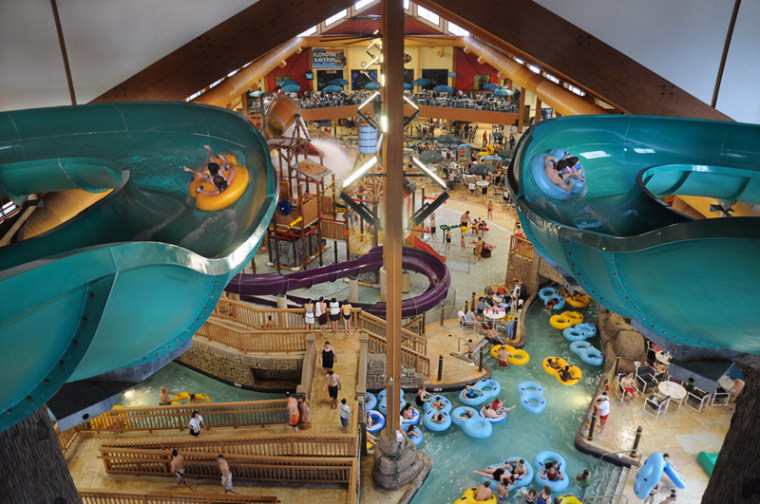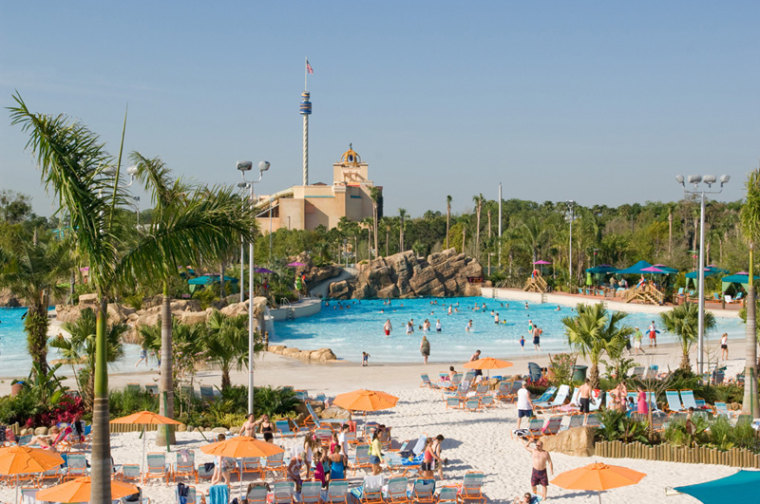Travel from your room to shopping, dining, and entertainment without setting foot on terra firma. No you’re not on a cruise, and this isn’t Venice. You’re at Schlitterbahn Vacation Village Water park in Kansas City, Kan.
Don’t pack your bags just yet. The water park, open in June, lets you traverse the park via a waterway that Schlitterbahn calls “transportainment:” Guests float in tubes from one attraction to the next through interconnected sides, chutes, and rivers.
Operating two of the top 20 most-visited water parks in the world (top 15 in the United States), Schlitterbahn has estimated the cost of its Kansas project at $750 million. “The idea is to bring the best of all three Schlitterbahns in Texas into this location,” says Marketing Director Chris Ozimek. The park opens with 16 attractions, including Storm Blaster, a coaster ride in which jets of water push riders uphill, setting them up for a steep downhill plunge, and Torrent River which, at 1,800 feet, is the longest tidal wave river in water parks worldwide.
According to Themed Entertainment Association, the 15 most-visited water parks in the country in 2008 attracted 12.5 million people. Although it only opened in March, Aquatica in Orlando, Fla., made the list at No. 4 with 950,000 visitors. In keeping with its status as a sister park of (and right across the street from) SeaWorld, Aquatica offers more than rides. In addition to exhibits and an underwater aquarium, trainers roam the park with animal ambassadors for interaction with guests. Rafters can float in a lagoon filled with exotic fish, and thrill-seekers can race through an enclosed tube into an underwater world that is home to a pod of dolphins.
Aleatha Ezra, director of park membership development for the World Water park Association, notes an increase in mixed-use projects combining water parks and adventure sports. “Surf simulators,” she says, “is a hot trend.” Many venues combine water parks with skiing, snowmobiling, and rock climbing. Plans for Schlitterbahn’s Vacation Village include an indoor skydiving simulation and a 221,000-square-foot sports store with shooting galleries, sport simulators, and a 65-foot Ferris wheel, as well as a 16,000-gallon aquarium.
Five of the 10 most well-attended water parks in the United States reside in Florida (the top four in Orlando: Aquatica, Disney World Typhoon Lagoon, Disney World Blizzard Beach, and the country’s first water park, Wet ’n Wild). “We (Floridians) really don’t go to the beach unless we live very close—and even then some don’t go,” says Brian Szaks of Orlando, a water park devotee. He visits the local venues 20 times a year and another five or six new ones on his travels. “Daytona Beach has a water park situated literally a block from the beach, and it is packed during the summer months. Water parks offer something that the beach can’t: thrills, drops, and a guarantee that you won’t get sand in uncomfortable places.”
Szaks’ favorite—for nostalgic reasons—is Noah’s Ark in Wisconsin Dells. It’s where he went to camp every summer as a young boy. “On the way, everyone always talked about The Plunge,” he says, describing a face-first slide with an 85-foot drop. “Only a few were brave enough to do it. It was straight down and had places that leveled out. You got air time; and if you could do that, you were ‘the man.’ It was almost like a bar mitzvah.” (For the record, Szaks became “the man” at age 9).
These days, the public expects more than an 85-foot drop, and the water park industry is trying to oblige. Year-old Aquatica has a 250-foot triple-drop ride and 300-foot racing slide. One of the newest in the ever-growing cadre of water park thrills is the Tantrum. Splish Splash on Long Island, N.Y., added one this year. The TantrumTWIST features dizzying turns and twists. Riders enter Dr. VonDark’s Tunnel of Terror on WhirlyWHEEL tubes and plummet four stories in darkness, travel through a water curtain on which scary images are projected, and drop into a funnel before flying out into a pool. Another Splish Splash attraction, the Cliff Diver slide, drops you eight stories in three seconds.
As if the extreme physical aspects of the rides weren’t enough, ride developers are adding increasingly sophisticated effects to create corresponding mind-blowing experiences. Introduced last summer at Schlitterbahn’s New Braunfels Water Park, for example, The Dragon’s Revenge incorporates original music, fiber optics, spin tunnels, faux fire, animation projected on a water screen, olfactory effects (the scent of burning), and—perhaps most telling—a story line about a dragon that has escaped hundreds of years of captivity in an ancient castle.

Water park operators also cater to people who vacation in seasons other than summer and look for multiple recreational opportunities in one locale. According to Ezra, hotels with indoor water parks have been a major trend in the water park industry over the past few years, especially in the Midwest. Wisconsin Dells, Wis., extended its Memorial-Day-to-Labor-Day tourism season by becoming the nation’s water park capital with 21 parks, only two of which do not have indoor attractions.
With the Dells leading the way, Wisconsin hosts the most water parks in the country (30), followed by Minnesota (14), Michigan (12), and Iowa (10). You won’t find them in the Southwest or Southeast or Hawaii, but there is one in Juneau, Alaska.
Kalahari Resorts operates the largest indoor water park under one roof in the United States (at Sandusky, Ohio), as well as Wisconsin’s largest indoor water park in the Dells. In December, Kalahari added an indoor theme park to its Wisconsin property. “We are always looking for different things that we can do to enhance our guests’ experience,” says Kalahari President Todd Nelson.
This summer, the Ohio park introduces Safari Adventures, an outdoor zoo with giraffes, ostriches, zebras, African antelope, kangaroos, and other land-based creatures. Displacing the notion that water parks are a “one-hit wonder,” today they have become destinations that attract multi-day vacationers. “We are really in an ever-changing industry,” Nelson says.
